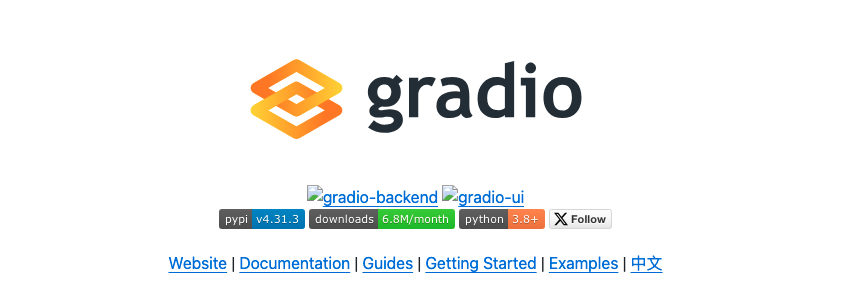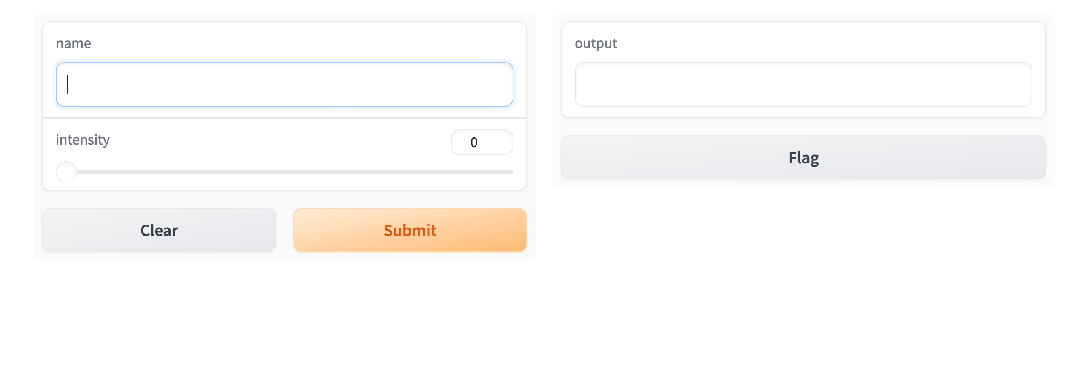29.4K star! 仅需几行代码快速构建机器学习 Web 应用项目,无需前端技能!
大家好,我是狂师!
今天给大家推荐一款开源的Python库:Gradio!
Gradio是一个开源的Python库,用于创建机器学习和数据科学的交互式应用和演示。
项目地址:
https://github.com/gradio-app/gradio
1、项目介绍
Gradio旨在简化展示和测试机器学习模型的过程,它允许用户通过构建漂亮的界面来展示其模型,而无需编写复杂的前端代码。通过Gradio,可以快速地为模型创建Web界面,并支持多种类型的输入和输出,如文本、图像和音频。这个库非常适合于快速迭代开发和用户反馈获取,以及在教学和展示中与观众互动。

通过提供简单的API,Gradio可以在几行代码中将任何Python函数转换为一个Web应用程序,无需前端开发经验。
2、工具用途
Gradio的主要用途包括:
- 展示和测试机器学习模型:通过创建具有输入字段(如文本输入或图像上传)和输出字段(如模型预测结果)的界面,用户可以直接与模型进行交互,从而测试和验证模型的性能。
- 演示机器学习模型:Gradio可以帮助开发者向客户、合作者和学生展示机器学习模型的功能和应用场景。通过创建简单漂亮的用户界面,可以更好地展示模型的预测效果和可视化结果。
- 快速部署模型:通过自动共享链接,Gradio可以快速部署机器学习模型,并使其在互联网上可用。这使得开发者可以轻松地与团队成员、合作伙伴或用户共享模型,并收集他们对模型性能的反馈。
- 交互式调试模型:在开发过程中,Gradio提供了内置的操作和解释工具,允许开发者交互式地调试机器学习模型。
3、安装、使用
可以使用pip进行安装,安装之前要确保python版本大于 3.8。
pip install gradio
示例1: 牛刀小试
import gradio as gr
def greet(name, intensity):
return "Hello " * intensity + name + "!"
demo = gr.Interface(
fn=greet,
inputs=["text", "slider"],
outputs=["text"],
)
demo.launch()
运行之后,在浏览器打开http://localhost:7860/即可访问web程序

示例2:生成外网地址
import gradio as gr
def greet(name):
return "Hello " + name + "!"
demo = gr.Interface(fn=greet, inputs="textbox", outputs="textbox")
demo.launch(share=True) # Share your demo with just 1 extra parameter 🚀
运行时候,就会自动生成一个URL链接,类似https://a23dsf231adb.gradio.live,可以将这个链接发给别人进行访问使用。当然你也可以选择将应用部署到云服务器。
示例3: 和FastAPI框架集成
from fastapi import FastAPI
import gradio as gr
CUSTOM_PATH = "/gradio"
app = FastAPI()
@app.get("/")
def read_main():
return {"message": "This is your main app"}
io = gr.Interface(lambda x: "Hello, " + x + "!", "textbox", "textbox")
app = gr.mount_gradio_app(app, io, path=CUSTOM_PATH)
# Run this from the terminal as you would normally start a FastAPI app: `uvicorn run:app`
# and navigate to http://localhost:8000/gradio in your browser.
示例4: 一个更为完整的示例
import os
from authlib.integrations.starlette_client import OAuth, OAuthError
from fastapi import FastAPI, Depends, Request
from starlette.config import Config
from starlette.responses import RedirectResponse
from starlette.middleware.sessions import SessionMiddleware
import uvicorn
import gradio as gr
app = FastAPI()
# Replace these with your own OAuth settings
GOOGLE_CLIENT_ID = "..."
GOOGLE_CLIENT_SECRET = "..."
SECRET_KEY = "..."
config_data = {'GOOGLE_CLIENT_ID': GOOGLE_CLIENT_ID, 'GOOGLE_CLIENT_SECRET': GOOGLE_CLIENT_SECRET}
starlette_config = Config(environ=config_data)
oauth = OAuth(starlette_config)
oauth.register(
name='google',
server_metadata_url='https://accounts.google.com/.well-known/openid-configuration',
client_kwargs={'scope': 'openid email profile'},
)
SECRET_KEY = os.environ.get('SECRET_KEY') or "a_very_secret_key"
app.add_middleware(SessionMiddleware, secret_key=SECRET_KEY)
# Dependency to get the current user
def get_user(request: Request):
user = request.session.get('user')
if user:
return user['name']
return None
@app.get('/')
def public(user: dict = Depends(get_user)):
if user:
return RedirectResponse(url='/gradio')
else:
return RedirectResponse(url='/login-demo')
@app.route('/logout')
async def logout(request: Request):
request.session.pop('user', None)
return RedirectResponse(url='/')
@app.route('/login')
async def login(request: Request):
redirect_uri = request.url_for('auth')
# If your app is running on https, you should ensure that the
# `redirect_uri` is https, e.g. uncomment the following lines:
#
# from urllib.parse import urlparse, urlunparse
# redirect_uri = urlunparse(urlparse(str(redirect_uri))._replace(scheme='https'))
return await oauth.google.authorize_redirect(request, redirect_uri)
@app.route('/auth')
async def auth(request: Request):
try:
access_token = await oauth.google.authorize_access_token(request)
except OAuthError:
return RedirectResponse(url='/')
request.session['user'] = dict(access_token)["userinfo"]
return RedirectResponse(url='/')
with gr.Blocks() as login_demo:
gr.Button("Login", link="/login")
app = gr.mount_gradio_app(app, login_demo, path="/login-demo")
def greet(request: gr.Request):
return f"Welcome to Gradio, {request.username}"
with gr.Blocks() as main_demo:
m = gr.Markdown("Welcome to Gradio!")
gr.Button("Logout", link="/logout")
main_demo.load(greet, None, m)
app = gr.mount_gradio_app(app, main_demo, path="/gradio", auth_dependency=get_user)
if __name__ == '__main__':
uvicorn.run(app)
4、小结
Gradio通过提供一个简洁的API和直观的界面,降低了创建交互式机器学习应用的技术门槛,特别适合入门级开发者和初学者使用。它的设计理念在于让开发者能够专注于模型的功能和性能,而不是耗费大量时间在界面设计和代码复杂化上。因此,无论是教学、研究还是商业演示,Gradio都是一个非常有价值的工具。
总的来说,你可以不用,但是你不能不知道,脑海里多一个方案,在解题时就能多一种选择。











【推荐】编程新体验,更懂你的AI,立即体验豆包MarsCode编程助手
【推荐】凌霞软件回馈社区,博客园 & 1Panel & Halo 联合会员上线
【推荐】抖音旗下AI助手豆包,你的智能百科全书,全免费不限次数
【推荐】博客园社区专享云产品让利特惠,阿里云新客6.5折上折
【推荐】轻量又高性能的 SSH 工具 IShell:AI 加持,快人一步
· DeepSeek “源神”启动!「GitHub 热点速览」
· 我与微信审核的“相爱相杀”看个人小程序副业
· 微软正式发布.NET 10 Preview 1:开启下一代开发框架新篇章
· 如何使用 Uni-app 实现视频聊天(源码,支持安卓、iOS)
· C# 集成 DeepSeek 模型实现 AI 私有化(本地部署与 API 调用教程)